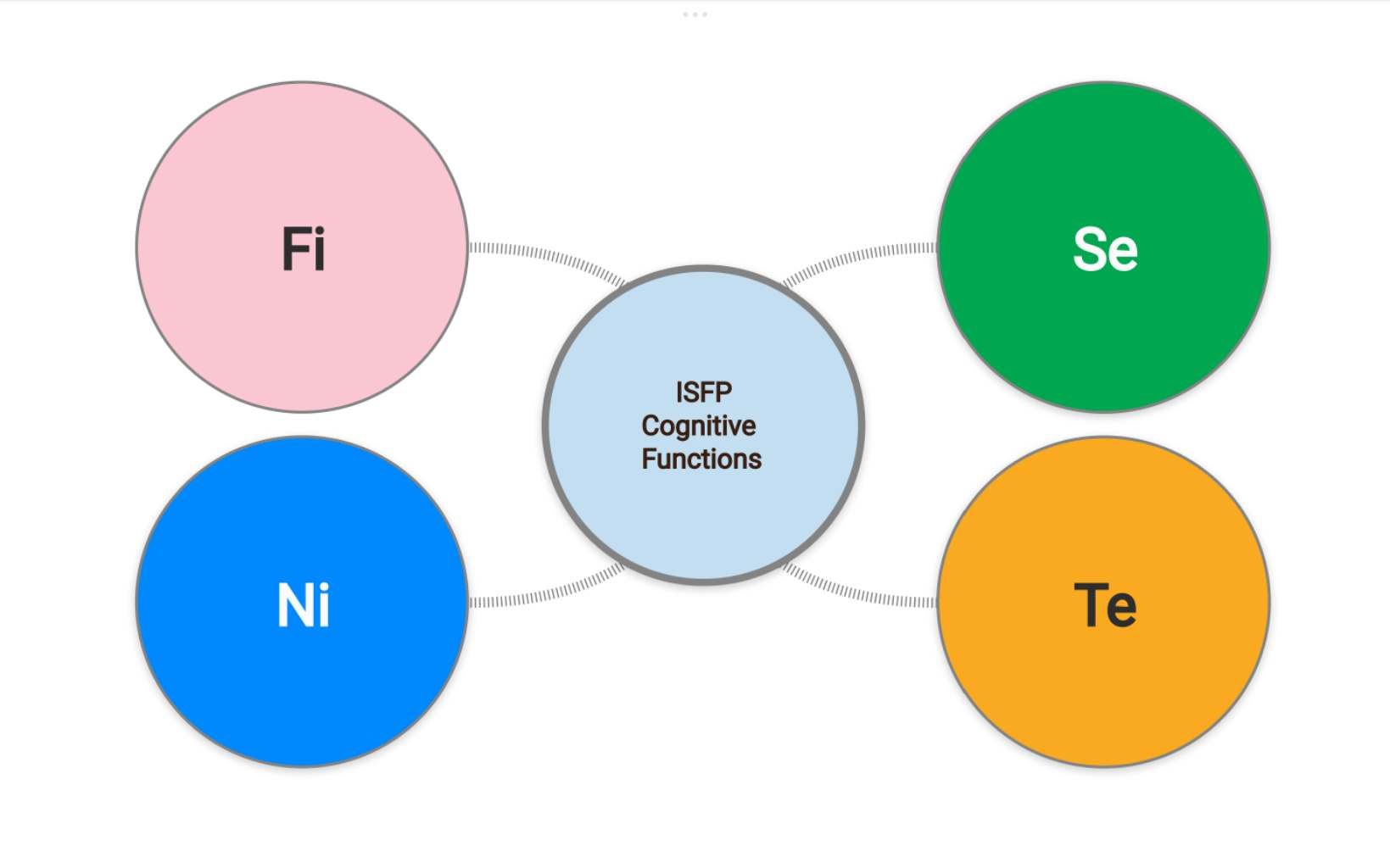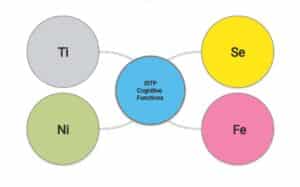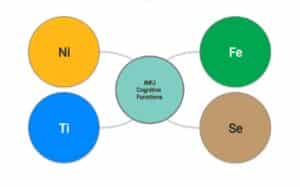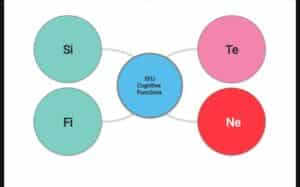Reading Time: 20 Minutes
So, you’ve heard about ISFPs and their unique vibe, but what’s really going on under the hood? Let’s dive into the world of ISFP Cognitive Functions—the mental gears that make ISFPs who they are. These functions shape how they think, feel, and interact with the world around them. We’ll break down each function in simple terms, so by the end, you’ll understand why ISFPs are such creative, sensitive, and sometimes mysterious souls.
The Four Cognitive Functions of ISFP
Alright, folks, buckle up! We’re diving into what makes an ISFP tick. You see, the ISFP personality type isn’t just a random mix of traits thrown together. It’s built on something called cognitive functions. Think of these as the inner gears that drive an ISFP’s thoughts, feelings, and actions. There are four of these gears, or functions, in every ISFP’s mind: two that are stronger (we call these the dominant and auxiliary functions) and two that are a bit weaker (these are the tertiary and inferior functions).
Each function has a specific role, kind of like different players on a football team. They work together to make the ISFP who they are, even if they sometimes trip over the ball (or each other). We’ll break these down one by one, so by the end, you’ll understand why your ISFP friend is such a unique blend of emotion, creativity, and that occasional “I-need-to-be-alone-right-now” vibe.

1. Dominant Function: Introverted Feeling (Fi)
Now, let’s start with the ISFP’s star player: Introverted Feeling, or Fi for short. If the ISFP were a pizza, Fi would be the crust. It’s the foundation of everything else. Fi is all about personal values and emotions. ISFPs don’t just feel things; they feel things deeply. They’ve got this internal compass that points them toward what’s right and wrong, based on their own experiences and beliefs.
Here’s the thing: Fi is an introvert. It likes to stay inside, under the radar. That’s why ISFPs often keep their strongest feelings to themselves. You might think they’re laid-back, but inside, they’re having a full-on concert of emotions—just without the audience. They’re the kind of folks who won’t easily tell you what they’re thinking unless they really trust you. And when they do, it’s usually something they’ve thought through carefully.
But don’t get it twisted—Fi isn’t about making decisions based on cold, hard logic. Nope, it’s all about what feels right to the ISFP. If something doesn’t sit well with their values, they’ll quietly steer away, even if everyone else is going the other direction. It’s like when you’re offered a dish you’ve never liked, and you just politely decline, no drama needed. ISFPs live by their personal code, and while they might not shout about it, they stick to it like glue.
2. Auxiliary Function: Extraverted Sensing (Se)
Alright, let’s move on to the next big player in the ISFP’s lineup: Extraverted Sensing, or Se. If Fi is the ISFP’s compass, Se is the thrill-seeker who drives the car. Se loves to be in the moment, soaking up every detail through the senses. ISFPs are incredibly in tune with what’s happening right here, right now. They notice things most people miss, like the way the sunlight hits the trees just so or how a melody can change the whole mood of a room.
Se is what makes ISFPs so good at appreciating beauty and creativity. It’s like they have this built-in radar for anything that’s visually or physically interesting. Whether it’s art, nature, or even a perfectly cooked meal, Se helps ISFPs experience it all with vivid intensity. They’re the ones who’ll stop to smell the roses—not just because they’re pretty, but because the scent, the color, and the texture all come together in a perfect sensory experience.
But Se isn’t just about enjoying life’s pleasures; it’s also about taking action. ISFPs can be spontaneous, jumping into new experiences headfirst. When Se is in the driver’s seat, they’re ready to explore the world, try new things, and live life to the fullest. Of course, this can sometimes lead to impulsive decisions, like when you grab that extra dessert without thinking, but hey, who can blame them? Life is too short not to enjoy it.
So, Se is all about engaging with the world in a hands-on, present-focused way. It’s what makes ISFPs adventurous, creative, and deeply appreciative of the here and now. They live through their senses, and that’s what gives their lives so much color and excitement.
3. Tertiary Function: Introverted Intuition (Ni)
Next up, we’ve got Introverted Intuition, or Ni, which is kind of like the ISFP’s mysterious third eye. Now, Ni isn’t as loud or obvious as Fi or Se. It’s more like that quiet friend who only speaks up when they’ve got something really important to say. Ni gives ISFPs those “aha!” moments—sudden flashes of insight or gut feelings about what might happen in the future.
Ni takes a backseat in the ISFP’s personality, so it’s not something they rely on all the time. But when it does kick in, it can be pretty powerful. Picture this: an ISFP might not always know why they feel a certain way about something, but Ni will occasionally send them a little nudge, saying, “Hey, trust your instincts on this one.” It’s like getting a sneak preview of what’s to come, but without all the details.
This function is all about connecting the dots, seeing patterns, and understanding things on a deeper level. ISFPs might not consciously realize it, but Ni is always working in the background, helping them make sense of their experiences and come to some pretty profound conclusions. It’s what adds that touch of wisdom to their otherwise sensory-driven nature.
However, since Ni isn’t as strong as the other functions, ISFPs might struggle with overthinking or getting stuck in abstract thoughts, especially when they’re stressed. It’s like trying to read a map in the dark—not impossible, but definitely challenging. When balanced, though, Ni helps ISFPs add depth to their creativity and gives them a sense of direction in life.
4. Inferior Function: Extraverted Thinking (Te)
Finally, we arrive at the ISFP’s least favorite function: Extraverted Thinking, or Te. If Fi is the artist and Se is the adventurer, Te is the stern manager who insists on organization, efficiency, and getting things done. But here’s the thing—Te is the ISFP’s weakest link. It’s like trying to force a cat to follow rules. They’ll do it, but only because they have to, not because they want to.
Te is all about logic, structure, and making sure everything runs smoothly. For ISFPs, this function feels a bit unnatural. They’re more comfortable going with the flow, following their heart, and enjoying the moment, rather than worrying about plans, schedules, or productivity. When Te does show up, it’s usually because the ISFP is stressed or needs to get something done that can’t be ignored—like filing taxes or organizing a big event.
In these moments, ISFPs might suddenly become super focused on getting things in order, but it’s often exhausting for them. Imagine trying to herd cats while juggling—doable, but definitely not fun. Te can push ISFPs to be more disciplined, but it doesn’t come naturally, and they usually prefer to get back to their more comfortable Fi and Se modes as soon as possible.
The good news is that with practice, ISFPs can develop their Te, which helps them balance out their emotional and sensory sides with a bit of practicality. It’s like learning to eat your veggies before dessert—not thrilling, but worth it in the long run. So while Te might be the ISFP’s weakest function, it’s still important for growth, helping them stay grounded and take care of the necessary (but often boring) tasks in life.
You Might Like To Read: ISTP Cognitive Functions (TiSe/NiFe): All 4 Functions Explained in Very Simple Manner
The ISFP Cognitive Function Stack in Everyday Life
Let’s talk about how all these fancy cognitive functions come together in the everyday life of an ISFP. Think of it like a team working together to get through the day—each function has its role, and while some are more active than others, they all contribute to how the ISFP experiences the world.
First off, Fi (Introverted Feeling) is always in the driver’s seat. It’s the part of the ISFP that makes decisions based on personal values. So, when an ISFP is deciding what to do, Fi is asking, “Does this feel right to me? Does it align with what I believe?” Whether it’s choosing a career, picking out an outfit, or deciding how to spend the weekend, Fi is guiding them towards what feels most authentic. In relationships, this means ISFPs are super loyal and genuine—they won’t fake it if they don’t feel it.
Next up, Se (Extraverted Sensing) is the fun-loving co-pilot who’s all about the here and now. Se makes sure the ISFP is soaking in every detail of their surroundings, whether they’re enjoying a sunset, tasting a new dish, or getting lost in music. In their daily life, Se drives the ISFP to explore and experience the world in a hands-on way. It’s why they might suddenly decide to go on a spontaneous road trip or spend hours perfecting a piece of art. Se keeps life exciting, making sure the ISFP doesn’t miss out on life’s little pleasures.
Then we have Ni (Introverted Intuition), which is like that quiet friend in the backseat who occasionally pipes up with deep insights. While Ni isn’t the main player, it helps the ISFP see connections and patterns that others might miss. For example, an ISFP might get a hunch about how a situation will unfold or have a sudden creative idea that seems to come out of nowhere. It’s not something they rely on all the time, but Ni adds a bit of depth and foresight to their decision-making. It’s what helps them think ahead, even if they’re usually focused on the present.
Finally, there’s Te (Extraverted Thinking), the part of the team that everyone kind of grumbles about but knows they need. Te is responsible for logic, organization, and getting things done. In an ISFP’s everyday life, Te might show up when they need to plan a trip, manage their finances, or meet a deadline. It’s not their favorite function, and it can feel a bit like trying to herd cats, but when it’s needed, Te helps the ISFP stay on track. It’s like eating your vegetables—not exciting, but necessary for a balanced life.
So, in everyday life, the ISFP’s cognitive functions work together to help them navigate the world in a way that feels true to who they are. Fi ensures they stay authentic, Se keeps them engaged with their surroundings, Ni adds a touch of intuition, and Te makes sure the important stuff gets done. It’s a unique blend that makes the ISFP creative, thoughtful, and deeply connected to the world around them.
Comparing ISFP Cognitive Functions with Other Types
Now, let’s do some friendly comparing—kind of like how you might compare different kinds of pizza. Every personality type has its own unique flavor, and ISFPs are no different. But how do they stack up against other types? Let’s break it down.
First, there’s the INFP. Both ISFPs and INFPs lead with Fi (Introverted Feeling), so they’re both driven by their personal values and emotions. But here’s where they differ: while ISFPs live in the moment with their Se (Extraverted Sensing), INFPs are all about possibilities and ideas, thanks to their Ne (Extraverted Intuition). Think of ISFPs as the friend who’s totally in the zone when painting a landscape, while INFPs are imagining what that landscape might look like on another planet.
Next, take the ESFP. These folks also love the present moment, just like ISFPs, because they lead with Se. But where ISFPs are more introspective and guided by their feelings, ESFPs are more outward-focused and social, thanks to their Fe (Extraverted Feeling). ISFPs might enjoy a quiet afternoon sketching in a park, while ESFPs might turn that same park into a stage for an impromptu dance-off.
Then there’s the ISTP. Both ISFPs and ISTPs share Se, which means they’re both very in tune with the physical world. But the ISTP’s main driver is Ti (Introverted Thinking), which makes them more logical and analytical. If the ISFP is savoring the beauty of a vintage car, the ISTP might be more interested in how the engine works. It’s like appreciating different aspects of the same thing—one is enjoying the aesthetics, while the other is figuring out how it all fits together.
So, while ISFPs share some similarities with other types, their unique blend of functions—especially the way Fi and Se work together—makes them stand out. They’re the artists, the adventurers, and the quiet rebels who stay true to themselves while embracing the beauty of the world around them.
Common Misconceptions About ISFP Cognitive Functions
Alright, let’s clear up a few things. Like any personality type, ISFPs are sometimes misunderstood. People might think they’ve got them all figured out, but there’s more to the story.
First up, the idea that ISFPs are “passive” or “indecisive.” Just because they don’t make a big show of their decisions doesn’t mean they don’t know what they want. ISFPs are guided by Fi, which means they’re deeply connected to their personal values. They might take their time to decide, but that’s because they’re making sure everything aligns with what feels right to them. It’s like picking out a pair of shoes—you might not see the process, but trust me, they know exactly what fits.
Another misconception is that ISFPs “lack intellect or analytical ability.” This one couldn’t be further from the truth. Just because ISFPs aren’t always logical in the traditional sense doesn’t mean they don’t think deeply. Their Ni gives them intuitive insights that can be just as sharp as any logical analysis. It’s like how you might just know which direction to take without needing to check a map—ISFPs have that kind of inner compass, even if it doesn’t always look like traditional reasoning.
Lastly, there’s the stereotype that all ISFPs are “just artists.” Yes, many ISFPs are drawn to creative fields, but Se drives them to explore and enjoy life in all sorts of ways. They might be musicians, athletes, chefs, or nature lovers. It’s not just about art; it’s about experiencing the world in a way that’s rich and full of sensory detail. So, while ISFPs do have a strong artistic streak, they’re not limited to just one form of expression.
Practical Tips for ISFPs to Enhance Their Cognitive Functions
Alright, ISFPs, if you want to level up your game, here are some tips to help you get the most out of your cognitive functions.
First, let’s talk about developing your Te (Extraverted Thinking). I know, I know, Te is like that annoying chore you keep putting off, but trust me, it’s worth it. Start small: make a to-do list or set up a simple budget. The idea is to bring a little more structure into your life without overwhelming yourself. Over time, you’ll find that being a bit more organized helps you stay on top of things without squashing your natural spontaneity.
Next, embrace your Se (Extraverted Sensing) even more. You’re already good at living in the moment, but try pushing it further. Take up a new hobby that engages your senses—like cooking, photography, or even rock climbing. The more you tap into Se, the more you’ll appreciate life’s little details, and you’ll find even more joy in the present moment.
For your Fi (Introverted Feeling), consider finding ways to express your values more openly. Whether it’s through art, writing, or simply having deeper conversations with those you trust, sharing your inner world can help you feel more connected and understood. Plus, it’ll help others see that your quiet strength is rooted in some seriously strong principles.
Lastly, nurture your Ni (Introverted Intuition) by giving yourself time to reflect. Whether it’s through journaling, meditation, or just taking a quiet walk, allowing space for those intuitive insights to come forward can help you see the bigger picture. You might find that you start to connect the dots in ways that surprise even you.
So, while ISFPs are already pretty awesome just the way they are, a little bit of conscious effort in developing these functions can help you lead an even more balanced and fulfilling life. After all, there’s always room to grow, and with these tips, you’ll be doing it in your own unique, ISFP style.
Conclusion On ISFP Cognitive Functions
Understanding ISFP Cognitive Functions gives you a peek into what drives these quiet yet passionate individuals. Their unique blend of feeling, sensing, intuition, and a dash of thinking makes them the thoughtful artists of the personality world. So, whether you’re an ISFP or just curious about how they tick, knowing these functions helps you appreciate the depth and richness they bring to life.
If you like the post, then please don’t forget to share with your friends.
Some Of The Previous Posts



